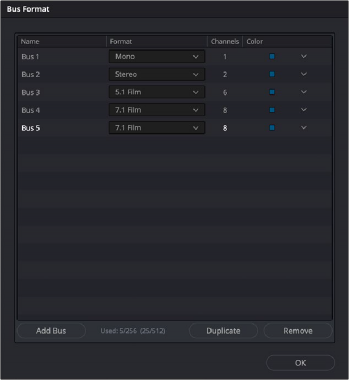
< Previous | Contents | Next >
The power of the FlexBus system is that it allows users to direct signals to many different places at one time, achieving complex mixing scenarios. Perhaps you need to generate two mixes that are identical in content but need to be of different output levels. You can designate two mix busses, one with an output level of -2dB true peak and one with an output level of -10dB true peak. The final mix signal is sent to one bus that is then broken into two more busses, one with a limiter set to -2dB and one set to -10 dB, creating these two different mixes at one time.

The FlexBus structure allows for many different bus track types to be created or changed.
Using Legacy Fixed Bussing
If you want to work using the previous method of Fixed Bus mapping, you can do so for new projects by opening the Fairlight panel of the Project Settings, and turning on the “Use fixed bus mapping” checkbox.
If your project has Fixed Bussing enabled and you want to change to FlexBus, then uncheck the “Use fixed bus mapping” checkbox. Note that once you have made the change it will not allow you to
change it back to legacy bussing. For more information see Chapter 173, “Mixing in the Fairlight Page.”
Converting Older Fixed Bus Projects to FlexBus
Older Fixed Bus projects can be converted to FlexBus by doing the following:
— Open Project Settings > Fairlight.
— Under the Bussing heading, uncheck “Use fixed bus mapping.”
— A dialog will appear allowing you to convert the project to FlexBus.